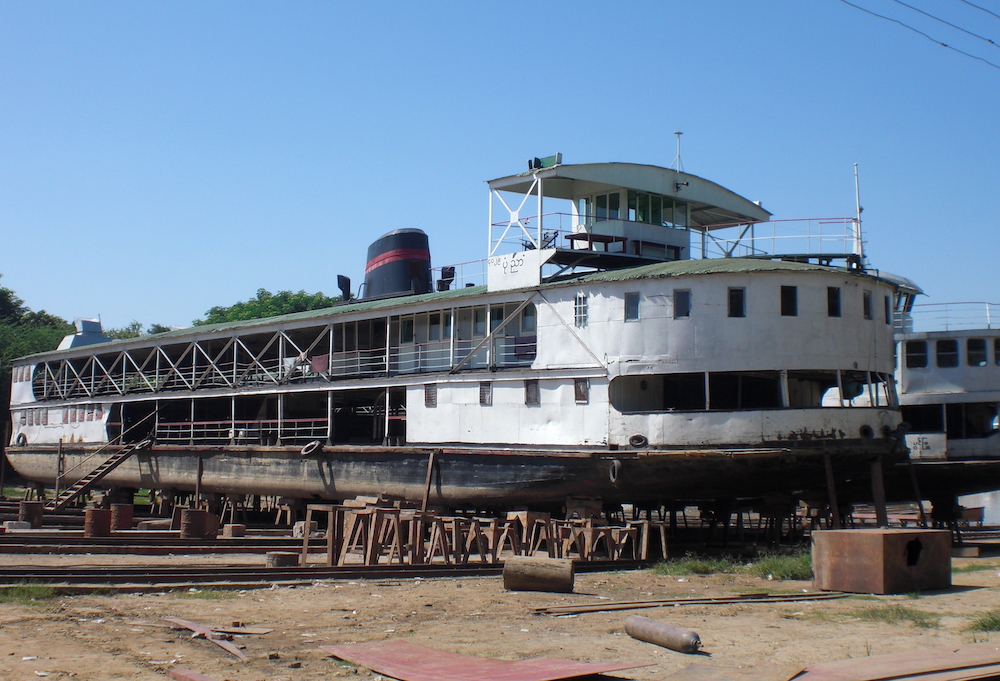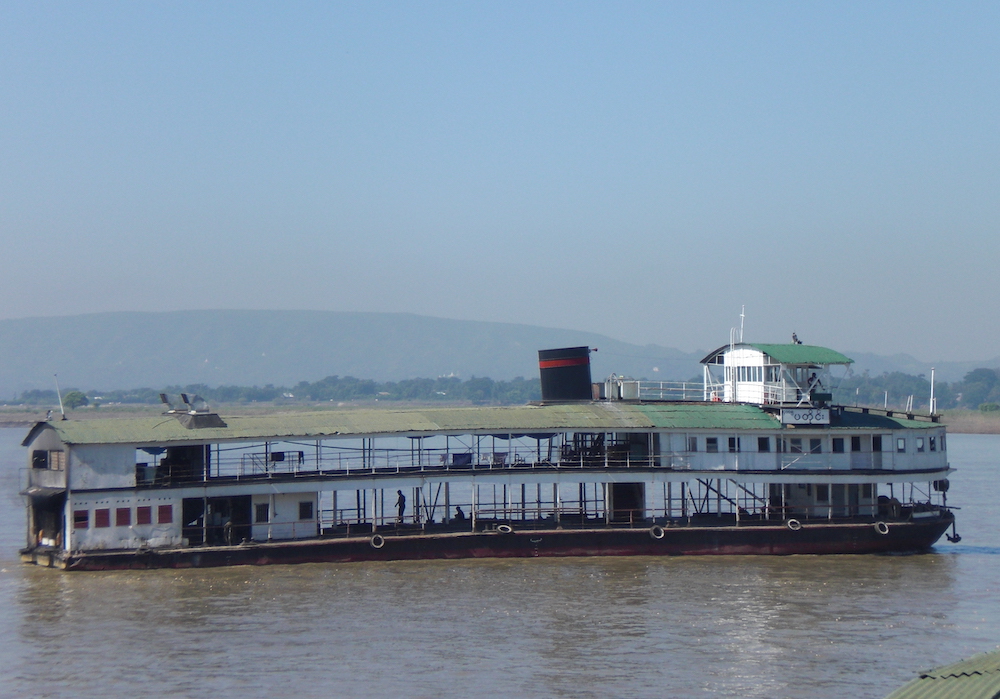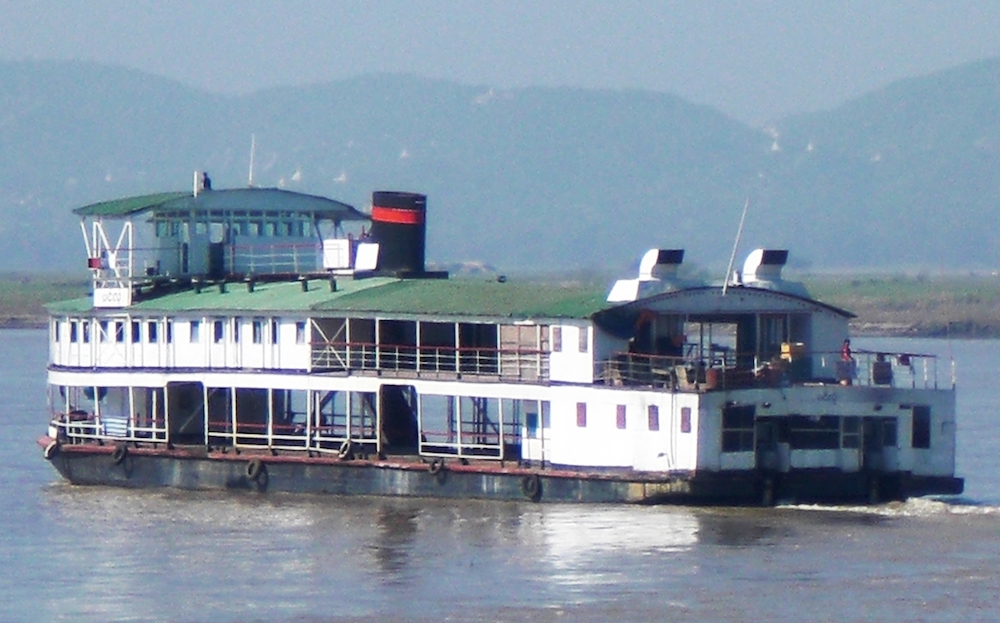An earlier version of this article first appeared in The Irrawaddy, Myanmar (Burma) on 4 March 2013. Photographs by the author, or as specified. You may use the images without prior permission for any scholarly or educational purpose as long as you (1) credit the photographer and (2) link your document to this URL in a web document or cite the Victorian Web in a print one. Click on the images to enlarge them. — JB

The IFC HQ inn, Rangoon.
If you take the Irrawaddy River route from the ancient temples of Bagan to the second city of Mandalay you will see, moored to the bank, a large old paddle steamer that once belonged to the Irrawaddy Flotilla Company. It is the last of what was once the finest river flotilla in the world.
The Minthamee was ordered in 1948 from the Glasgow firm Yarrow of Scotstoun. Renamed the Moiat Yadana, it was commandeered by the late dictator General Ne Win, who ruled Burma from 1962 until 1988 and was used as his private yacht and later as a restaurant. The Irrawaddy Flotilla Company, which operated in Burma from 1865 until the late 1940s, once comprised more than 500 vessels of which about 180 were powered paddle steamers and the remainder barges and "flats" for carrying cargo.
The IFC payroll included more than 11,000 engineers, crew, dockyard workers plus head office staff. Its self-confidence is demonstrated by its colonnaded head office, one of the finest buildings in Rangoon (now Yangon), shown above right, and "Belmont", the house of the general manager, which is now the Residence of the British Ambassador.
There was always a strong Scottish connection. Until independence in 1948 most of the 200 British staff in Burma were Scots and almost all the powered paddle steamers were built in Glasgow. The company itself, founded in 1865 and reconstituted in 1876, was incorporated in Glasgow but administered locally from an imposing building at 50 Phayre Street, Rangoon, now renamed Pansodan Street.
To operate on the Irrawaddy is no easy task. It is one of the mightiest rivers in the world but also, for much of its length and for much of the year, it is extraordinarily shallow. Starting in the Himalayas, it carries melted snow towards the Bay of Bengal from April, supplemented from May by the monsoon rains which swell the river until October,reaching its high water mark in August. Then the river begins to fall and between December and April reaches its lowest levels in February; some 11 meters lower than August.
At Hinthada, the river is up to 4 miles wide but in the last 1100 miles to the sea there is only a contour drop of 500 feet. Nonetheless there is also a vast amount of alluvial silt carried downstream which ends up in the large delta where nine separate branches reach the sea. In the far north it is almost impossible to use the river above Bhamo during the dry season. Even today, when the railway provides competition, the river remains the most important transport artery in Burma. Huge teak logs are shipped down from the north, rice grown in paddies irrigated by the river is sent for export, and imports from China arrive via Bhamo before being distributed downstream to Mandalay and Rangoon.


Raphael Tuck postcards dating from the early twentieth century. Left: Irrawaddy Express Steamer. Right: Rangoon River scene.
Large numbers of passengers travel on the river, particularly in the busy Irrawaddy Delta. It was estimated that about 44 percent of Burma's freight was carried on the river in 2002. A company pamphlet published in the 1930s described the diversity of cargo carried by the flotilla "Great bales of cotton, bags of rice, blocks of jade, lacquer ware, silk, tamarind, elephants sometimes, woven mats, maize, jaggery, bullocks, marble Buddhas, oil cake, tobacco, timber." In upward-bound cargoes would be found all the various imports from Europe; motor cars, corrugated iron, condensed milk, matches, aluminium-ware, sewing machines, piece goods, soap, cigarettes, cement and whisky.
The Irrawaddy Flotilla's history runs parallel to many of the events during the British colonial period. On occasions the paddle steamers carried British troops up and down the river. They also carried Burma's last king Thebaw into exile in 1885 and the Prince of Wales (the future King George V) during his visit in 1906. He travelled on the steamer Japan whereas the Viceroy of India took the Mysore in 1937 and the Crown Prince of Thailand, appropriately, the Siam also in 1906.
The Japan, Mysore and Siam were three of the largest and fastest steamers in the fleet; the Siam and Japan, built in 1903 and 1904 respectively, and the Mysore, built in 1913, were all over 300 feet long. All three were built by William Denny and Brothers Limited, a Scottish shipbuilding company in Glasgow.
Indeed over 75 percent of all IFC vessels were built by Denny, whereas most of the remainder was constructed by other old Scottish shipbuilders, such as A. and J. Inglis Limited, Robert Duncan and Co. of Port Glasgow, and Yarrow of Scotstoun. With over 600 vessels ordered over a period of 90 years the Irrawaddy Flotilla Company was a significant customer for Glasgow shipbuilders.
William Denny and Brothers Limited's were known for innovation, producing river boats for some of the world's great rivers; the Indus, Tigris, Ganges, Hooghly, Nile and even the Mississippi. Denny and Yarrow would build the craft and then disassemble them for reassembly on arrival at Rangoon.
The IFC had a shipyard called Dalla just across the river from Rangoon with several slipways and a smaller repair yard in Mandalay. These shipyards still operate and much of the equipment is unchanged since the 1940s, some of it made in Glasgow.

A vessel undergoing repairs on wooden trestles.
Building craft for shallow rivers is complex because they rely for their hull strength on a steel box construction instead of a keel. This may explain the slightly concave shape which many of the vessels have developed sixty or seventy years later.

The distinctive concave shape is apparent here.
The nadir of the flotilla's fortunes came with the Japanese invasion of Burma in March 1942. As the Japanese forces swept northwards it was decided to use IFC vessels to evacuate British and Indian troops up the Irrawaddy and then as far as possible up the Chindwin until the waters became too shallow. From there the troops had to march back to India.
To stop the fleet from falling into Japanese hands, 200 vessels were sunk at Mandalay and the remainder scuppered at Katha. The Siam and the Mysore were used as hospital ships and then sunk with all the others. A manager wrote on 3 May 1942, "Katha is a sight, vessels anchored ten abreast and all deserted. The last train has gone, the town is evacuated. Parties are told off to sink every vessel." It was a tragic end to the mighty Irrawaddy Flotilla.
When the British and Indian Armies recaptured Burma from the Japanese three years later, they inherited some vessels which the Japanese had managed to salvage. However, the IFC only took control of a small number of the craft. The majority were controlled by the British military government.
This led to an argument when Burma obtained her independence in 1948. On 1 June 1948, the Irrawaddy Flotilla was nationalized and replaced by Burmese state-owned enterprise, the Inland Water Transport Board. The Glasgow owners were only compensated for the 105 salvaged vessels (only 19 of which were powered craft) plus some buildings and equipment. The military fleet was not included, nor were any vessels built since the war.
Nonetheless, Glasgow — itself recovering after wartime bombing — was grateful for the new orders. William Denny and Brothers Limited built four 200 foot paddle steamers, while Yarrow constructed four more of the same class. One of these was the Minthamee. Then in 1956 Yarrow shipyard received the last order from Burma for five quarter-wheelers (with large paddles at the stern rather than at the sides).
Visitors to Burma today will be amazed to see that the remnants of the Irrawaddy Flotilla are still operating in what has been a remarkable exhibition of making do and patching up old craft with minimal access to spare parts and modern expertise. For the past half century Burma has been in self-imposed isolation and more recently has been subject to international sanctions.
As well as maintaining the existing craft, Burma's Inland Water Transport shipyards have actually constructed some new vessels and a considerable number of flats and barges. The shipyards themselves are a marvel, a throwback to the nineteenth century with large vessels literally supported on wooden trestles. Shipyard workers operate welding torches on the river banks without any form of protection, and no work benches.
All the other paddle steamers and stern-wheelers have been converted to stern propellers, many of them built by the British company Sykes Marine of Thurrock. Their Hydromaster engine is like a giant outboard motor but is telescopic so that the propeller can be raised in particularly shallow waters.

An old quarter wheeler with its paddles replaced by Hydromaster engines.
It is to the credit of the Inland Water Transport that they still run 400 vessels, of which 200 are powered, and they still employ 4000 staff. The captains and pilots have to be more skilled than ever because river levels are now even shallower due to silting and, it is claimed, to climate change. The captains have no electronic aides and still use the old technique of bamboo poling to find the deeper channels.
When this article was first written (in 2013) Burma was increasingly opening up to the world and with some sanctions gradually being lifted. There seemed to be a brighter future ahead for the Inland Water Transport. There was talk of acquiring new vessels and access to training overseas. Furthermore, there were opportunities to explore options for dredging the river and increasing access north of Bhamo. Sadly recent developments in the country have made those ambitions seem more remote.
The days of the old Irrawaddy Flotilla craft are surely numbered. One has been bought by a private company which offers luxury cruises on the Irrawaddy and the Mekong. Perhaps the biggest surprise, however, is that the Inland Water Transport management is proud that the whole fleet sports the original black and red funnels of the old Irrawaddy Flotilla and the Glasgow connection.
Links to Related Material
- The River Clyde and Its Importance to Glasgow
- On the Ayeyarwady River from Mandalay to Bagan
- The New Floating Dry Dock at Rangoon
- Boat Building near the Chindwin River
- Wreck of a Mail-Steamer on the Irrawaddy between Mandalay and Prome
- Sudden Death in a Burmese Paradise
- The High Hopes and Sad Demise of the Indus Flotilla
Further Reading
McCrae, Alister, and Alan Prentice. Irrawaddy Flotilla. Paisley: James Paton, 1978.
Stevenson, John. Irrawaddy: Benevolent River of Burma. Singapore: Times Editions, 2004.
William Denny and Brothers. Grace's Guide to British Industrial History.
Created 18 September 2024
